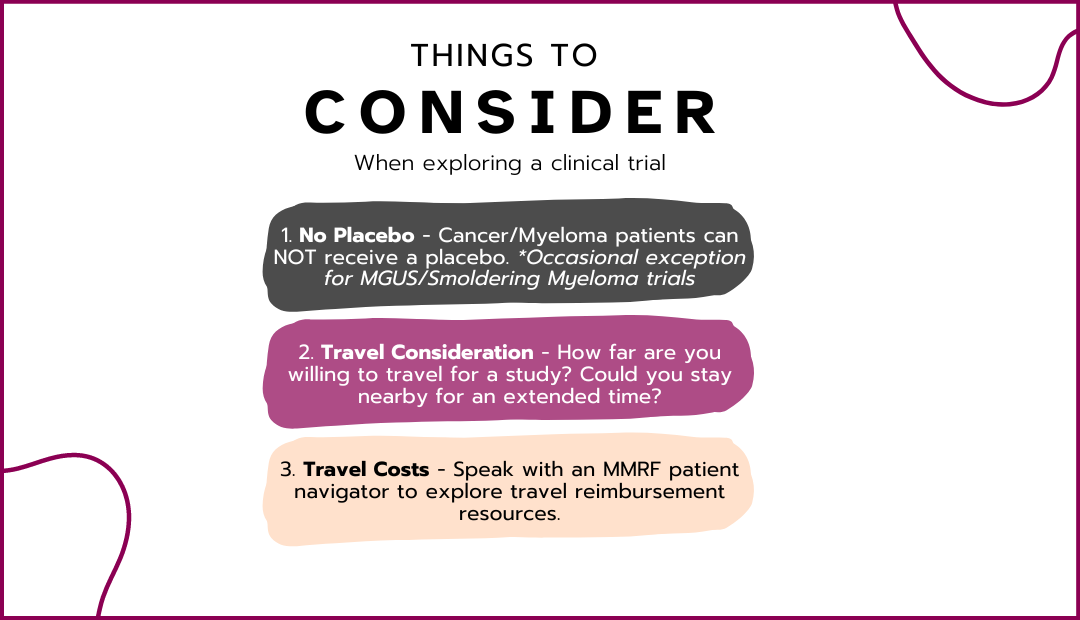Comparing the Combination of Selinexor-Daratumumab-Velcade-Dexamethasone (Dara-SVD) With the Usual Treatment (Dara-RVD) for High-Risk Newly Diagnosed Multiple Myeloma
NCT06169215
Age Any Age.
Sex Both
Phase Phase 2
Third Opinion Trial Synopsis
In this clinical study, researchers are exploring a new treatment approach for patients with a specific type of blood cancer. The study focuses on a combination of therapies that aim to improve patient outcomes and potentially offer a more effective treatment option. Here are some key details about the study:
- The study investigates a combination of existing therapies, which may enhance their effectiveness when used together.
- It includes a diverse group of participants, allowing researchers to gather data on how different individuals respond to the treatment.
- One unique aspect of this study is its focus on a specific patient population, which may help tailor treatments to those who need them most.
- The study aims to assess not only the effectiveness of the treatment but also its safety and tolerability for patients.
- Researchers are using advanced monitoring techniques to track patient responses and side effects throughout the treatment process.
Third Opinion AI Generated Synopsis
Trial Summary
This phase II trial compares the combination of selinexor, daratumumab, velcade (bortezomib), and dexamethasone (Dara-SVD) to the usual treatment of daratumumab, lenalidomide, bortezomib, and dexamethasone (Dara-RVD) in treating patients with high-risk newly diagnosed multiple myeloma. Selinexor is in a class of medications called selective inhibitors of nuclear export (SINE). It works by blocking a protein called CRM1, which may keep cancer cells from growing and may kill them. Daratumumab is in a class of medications called monoclonal antibodies. It binds to a protein called CD38, which is found on some types of immune cells and cancer cells, including myeloma cells. Daratumumab may block CD38 and help the immune system kill cancer cells. Bortezomib blocks several molecular pathways in a cell and may cause cancer cells to die. It is a type of proteasome inhibitor and a type of dipeptidyl boronic acid. Dexamethasone is in a class of medications called corticosteroids. It is used to reduce inflammation and lower the body's immune response to help lessen the side effects of chemotherapy drugs. Lenalidomide is in a class of medications called immunomodulatory agents. It works by helping the bone marrow to produce normal blood cells and by killing abnormal cells in the bone marrow. The drugs daratumumab, lenalidomide, bortezomib, dexamethasone and selinexor are already approved by the FDA for use in myeloma. But selinexor is not used until myeloma comes back (relapses) after initial treatment. Giving selinexor in the initial treatment may be a superior type of treatment for patients with high-risk newly diagnosed multiple myeloma.
This phase II trial compares the combination of selinexor, daratumumab, velcade (bortezomib), and dexamethasone (Dara-SVD) to the usual treatment of daratumumab, lenalidomide, bortezomib, and dexamethasone (Dara-RVD) in treating patients with high-risk newly diagnosed multiple myeloma. Selinexor is in a class of medications called selective inhibitors of nuclear export (SINE). It works by blocking a protein called CRM1, which may keep cancer cells from growing and may kill them. Daratumumab is in a class of medications called monoclonal antibodies. It binds to a protein called CD38, which is found on some types of immune cells and cancer cells, including myeloma cells. Daratumumab may block CD38 and help the immune system kill cancer cells. Bortezomib blocks several molecular pathways in a cell and may cause cancer cells to die. It is a type of proteasome inhibitor and a type of dipeptidyl boronic acid. Dexamethasone is in a class of medications called corticosteroids. It is used to reduce inflammation and lower the body's immune response to help lessen the side effects of chemotherapy drugs. Lenalidomide is in a class of medications called immunomodulatory agents. It works by helping the bone marrow to produce normal blood cells and by killing abnormal cells in the bone marrow. The drugs daratumumab, lenalidomide, bortezomib, dexamethasone and selinexor are already approved by the FDA for use in myeloma. But selinexor is not used until myeloma comes back (relapses) after initial treatment. Giving selinexor in the initial treatment may be a superior type of treatment for patients with high-risk newly diagnosed multiple myeloma.
from ClinicalTrials.gov
Locations & Contact
Fill out the form and to let the Multiple Myeloma Research Foundation know you are interested in this trial.
Contacts:

